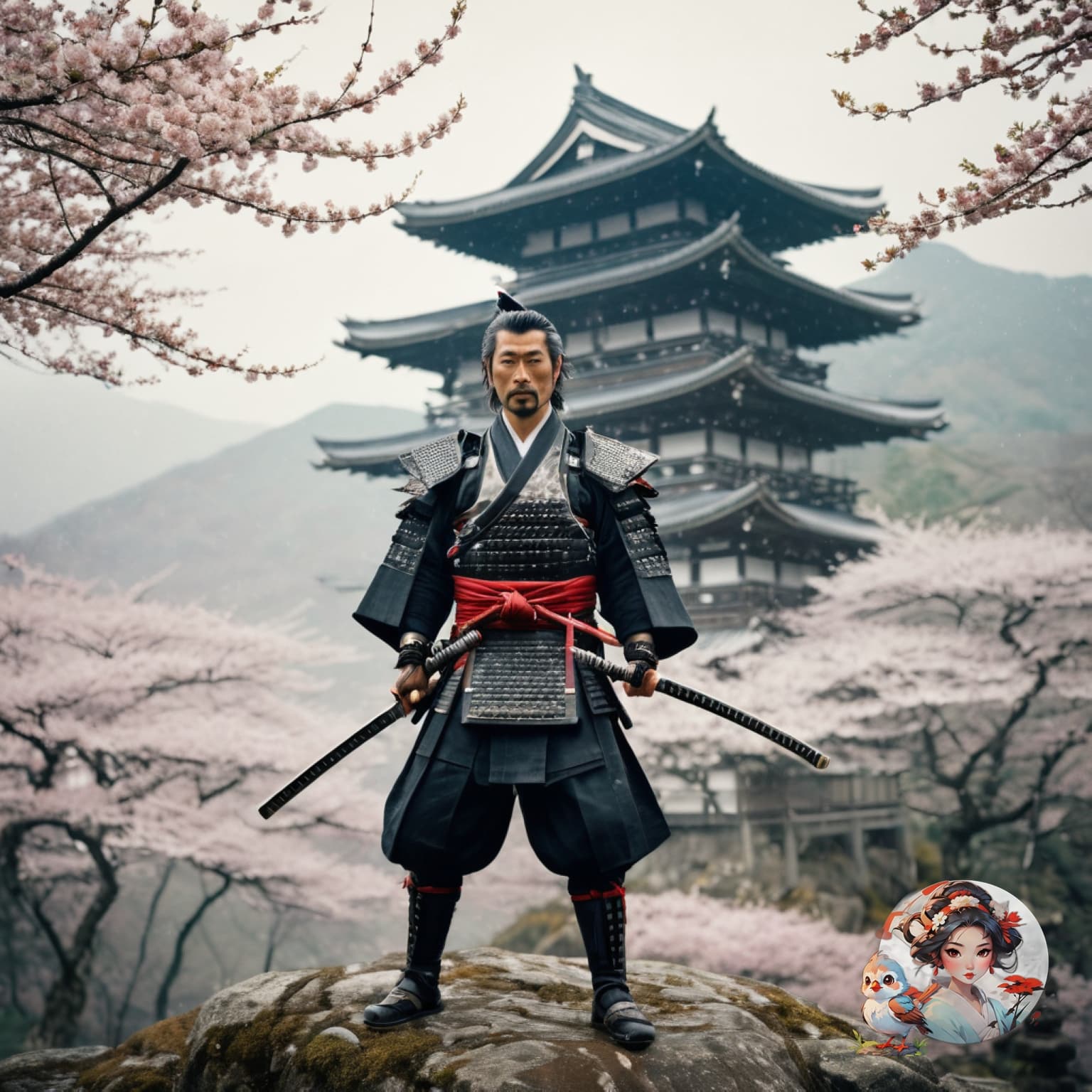Born in 1584, Miyamoto Musashi remains an iconic figure in Japanese history. Imagine a young boy in the province of Harima, facing personal challenges but determined to master the art of the sword. At the age of 13, he fought his first duel and emerged victorious. Each subsequent duel honed his skills and shaped his character, culminating in his famous victory over Sasaki Kojirō on Ganryujima Island.
Musashi’s ingenuity shone at key moments such as the Battle of Sekigahara and the Shimabara Rebellion. He revolutionised swordsmanship with his Niten Ichi-ryū style, which involved the simultaneous use of two swords. Beyond his martial prowess, Musashi was also an artist and a thinker, leaving behind a legacy as complex and compelling as his battles.
Curious to know more about this fascinating character?
Table of Contents
ToggleBorn in 1584 in Harima Province, Miyamoto Musashi was the son of Shinmen Munisai, a respected martial artist. Musashi’s childhood was marked by a unique upbringing and numerous challenges. Suffering from eczema, he avoided bathing, which must have been particularly difficult. His father, Munisai, played an important role in his early training, instilling the principles of martial arts in him from an early age.
Imagine a young boy learning the art of the sword while his peers were playing. This rigorous discipline and strong family influence shaped Musashi and prepared him for the future. His early life was challenging, but these experiences built his resilience and laid the foundation for the legendary samurai he would become.
At the age of 13, Miyamoto Musashi fought his first duel and emerged victorious against the skilled swordsman Arima Kihei. This early encounter marked the beginning of his remarkable career. At the age of 16, he faced Tadashima Akiyama and demonstrated his growing skill. By the age of 21, Musashi’s victories over several opponents in Kyōtō had cemented his reputation as an exceptional swordsman. Each victory wasn’t just a fight; it was an important step on his journey, illustrating his strategic mind and martial prowess.
These early duels were crucial in shaping Musashi’s spirit and determination. More than mere battles, they were formative experiences that laid the foundation for his enduring legacy.
Miyamoto Musashi’s military campaigns are notable for his participation in pivotal battles such as the Battle of Sekigahara in 1600 and the Shimabara Rebellion. His strategic acumen and fighting skills were clearly demonstrated in these conflicts. Renowned for his tactical skills and leadership, Musashi forged alliances that enhanced his battlefield strategies. His ability to read the battlefield and adjust his tactics accordingly earned him the respect of his peers.
Musashi’s expertise extended beyond personal duels to the orchestration of large-scale manoeuvres. This demonstrated his comprehensive understanding of warfare. These experiences honed his skills and contributed greatly to his legendary status, cementing his influence on Japanese military history.
The Battle of Sekigahara in 1600 was a decisive conflict that paved the way for the Tokugawa Shogunate and marked an important episode in Miyamoto Musashi’s military career. Musashi sided with the Eastern Army and played a crucial role in this historic event. His extraordinary battle strategy in the midst of chaos contributed greatly to the final victory.
As the Eastern Army clashed with the Western forces, Musashi’s tactical skills stood out and earned him a reputation for excellence. This participation not only demonstrated his martial prowess, but also aligned him with the victorious Tokugawa regime.
This pivotal moment in Japanese history cemented Musashi’s position as a notable samurai. His influence would be felt for generations to come, shaping the future of Japanese martial arts and strategy.
Musashi’s duel with Sasaki Kojiro on the island of Ganryujima in 1612 remains a significant event in samurai history. This encounter highlighted the rivalry between two master swordsmen. Musashi, known for his unique techniques, faced Kojiro, famous for his ‘swallow cut’. On Ganryu Island, the anticipation was intense as the two warriors prepared.
Musashi arrived late and showed his resourcefulness by fashioning a wooden sword from a boat oar. The ensuing clash was swift and decisive. Musashi’s strategic thinking and adaptability won the day. This duel not only secured Musashi’s legacy, but also influenced the art of swordsmanship, echoing throughout history.
After his legendary duel with Sasaki Kojirō, Musashi established the Niten Ichi-ryū style, which emphasised the mastery of two swords at once. This innovative approach transformed traditional swordsmanship and made Musashi a major figure in martial arts philosophy.
Imagine Musashi wielding both a katana and a wakizashi with an almost otherworldly fluidity. His teachings went beyond physical prowess, focusing on mental discipline and urging practitioners to find harmony between mind and body. It must have been exciting to study under such a master.
The Niten Ichi-ryū style wasn’t just about fighting; it was a holistic path that combined strategy, precision and deep introspection. This approach transformed swordsmanship into an art form that transcended the battlefield.
Miyamoto Musashi’s artistic contributions went beyond hobbies; they were integral to his philosophical and martial mastery. His sumi e paintings, often depicting serene landscapes and solitary animals, demonstrated his appreciation of simplicity – a key principle in his swordsmanship. In his calligraphy, Musashi honed precision and fluidity, essential qualities for any warrior. Each brush stroke required the same concentration and discipline as a skilled sword stroke.
Miyamoto Musashi’s cultural legacy extends far beyond his lifetime, influencing martial arts, Japanese literature, art and modern media. His samurai philosophy, which combines discipline with artistry, has inspired generations. Musashi’s life and teachings can be found in classic works such as Eiji Yoshikawa’s novel ‘Musashi’, as well as in manga and anime. These stories captivate audiences with his martial arts prowess and strategic genius.

His influence is evident in video games and films, where he often represents the quintessential samurai spirit. More than swordsmanship, Musashi’s legacy is a timeless tale of resilience, wisdom and the pursuit of mastery. This enduring story continues to inspire and engage people around the world.